Get free scan and check if your device is infected.
Remove it nowTo use full-featured product, you have to purchase a license for Combo Cleaner. Seven days free trial available. Combo Cleaner is owned and operated by RCS LT, the parent company of PCRisk.com.
What is search.bannabell.com?
Search.bannabell.com is a fake search engine, supposedly capable of optimizing download/installation processes and generating improved search results. Judging by appearances alone, search.bannabell.com is very similar to Google, Yahoo, Bing and other legitimate search engines.
Therefore, it arouses no immediate suspicions and uses often believe it be legitimate and functional. However, developers of this website promote it through download/installation setups of browser-hijacking applications. These apps modify browser settings without users consent.
Additionally, search.bannabell.com spies on users' browsing activity, thereby gathering their personal information.
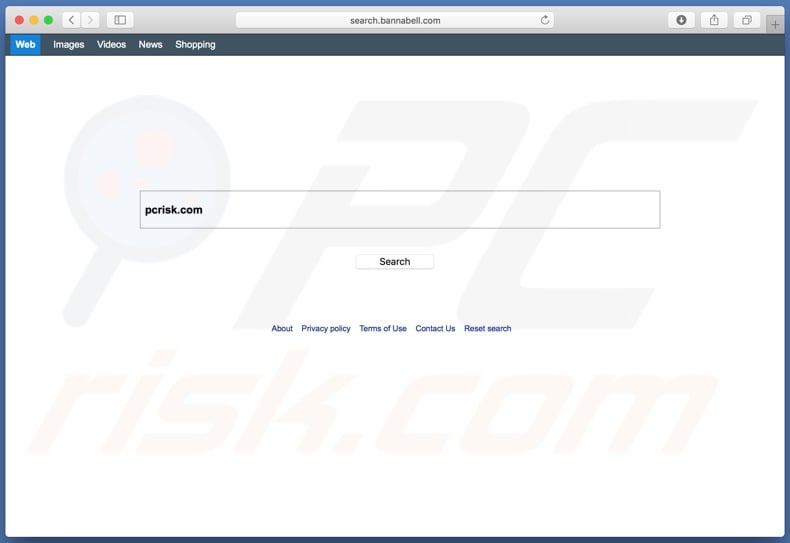
Rogue setups usually target Safari, Google Chrome, Mozilla Firefox and other popular browsers. They operate by assigning browser's homepages, default search engines and new tab/window URLs - to search.bannabell.com. Furthermore, they install additional applications and/or browser extensions/plug-ins.
These "helper objects" reset any changes made by users. Therefore, recovering control over the affected browser is impossible, unless the undesirable additions are uninstalled. Users attempting to use a hijacked browser will find that every new tab/widow opened and searches via the URL bar will redirect to search.bannabell.com.
However, this fake web searching tool is unable to generate search results, therefore it redirects to search.yahoo.com - a legitimate search engine. Such unauthorized redirects seriously diminish the browsing experience. What is more, search.bannabell.com and its "helper objects" continuously gather information, relating to users' browsing habits.
This data includes visited website URLs, pages viewed, search engine history, IP address, geolocation and so on. What is crucial to understand, is that this data contains personal information, which is passed onto third parties (potentially, cyber criminals), seeking to generate revenue by misusing it.
This can result in severe privacy issues and even identity theft. Should users experience redirects to search.bannabell.com, they are advised to immediately remove all suspicious apps and browser extensions/plug-ins.
| Name | Bannabell browser hijacker |
| Threat Type | Mac malware, Mac virus |
| Serving IP Address | 3.208.185.26 |
| Symptoms | Your Mac became slower than normal, you see unwanted pop-up ads, you get redirected to shady websites. |
| Distribution methods | Deceptive pop-up ads, free software installers (bundling), fake flash player installers, torrent file downloads. |
| Damage | Internet browsing tracking (potential privacy issues), displaying of unwanted ads, redirects to shady websites, loss of private information. |
| Malware Removal (Windows) |
To eliminate possible malware infections, scan your computer with legitimate antivirus software. Our security researchers recommend using Combo Cleaner. Download Combo CleanerTo use full-featured product, you have to purchase a license for Combo Cleaner. 7 days free trial available. Combo Cleaner is owned and operated by RCS LT, the parent company of PCRisk.com. |
Most fake search engines are very similar. Search.pardessov.com, search.searcherzip.com, search.globalsearch.pw are examples of web searchers identical to search.bannabell.com.
They typically offer improved search results, often with some supplementary "useful" features (e.g. download/install process optimizers, weather forecasts, quick access to latest news and etc.). Fake web searching tools attempt to give the impression of legitimacy and frequently succeed in this endeavor.
However, their only purpose is to generate profit for their developers, therefore all advertised features are usually nonoperational. Instead, these fraudulent search engines cause redirects to sale-based, untrustworthy, malicious websites and gather private data.
How did search.bannabell.com install on my computer?
As mentioned in the introduction, search.bannabell.com is promoted by rogue download/installation setups. This deceptive marketing technique is called "bundling". User tendency to rush through these processes, enables developers of malignant content to spread their products.
All the information regarding how an application or browser extension/plug-in will operate (e.g. modify browser settings, track data and etc.) is buried within lengthy download/install terms or hidden within other similar sections.
In most cases, it is possible to opt-out from downloading/installing these malicious additions, however such options are often located in the "Custom/Advanced" settings. By acting hastily and skipping download/installation steps, users can unintentionally allow undesirable content into their systems.
Thereby, exposing their browsers and devices to various invasions/infections, as well as endangering their privacy.
How to avoid installation of potentially unwanted applications?
It is strongly advised to use only official and verified download sources. Since potentially unwanted applications (PUAs) are distributed "bundled" with ordinary software, users should carefully pick their downloading sources and employ caution when installing it.
Download/installation terms should be read, all windows/steps of these processes analyzed. It is also recommended to use "Custom/Advanced" settings to opt-out from downloading/installing additional content. Intrusive advertisements are also known to proliferate unwanted apps.
Usually hosted by compromised webpages or delivered by adware-type PUAs, they can execute scripts to make rogue downloads/installs of undesirable content. Therefore, uses should refrain from clicking various ads, as the intrusive type usually look absolutely ordinary.
However, they redirect to dubious websites (e.g. pornography, adult-dating, gambling and similar).
Should users encounter suspicious redirects, they are strongly advised to check their systems and remove all suspect applications and/or browser extensions/plug-ins. If your computer is already infected with browser hijackers, we recommend running a scan with Combo Cleaner Antivirus for Windows to automatically eliminate them.
Website promoting search.bannabell.com:
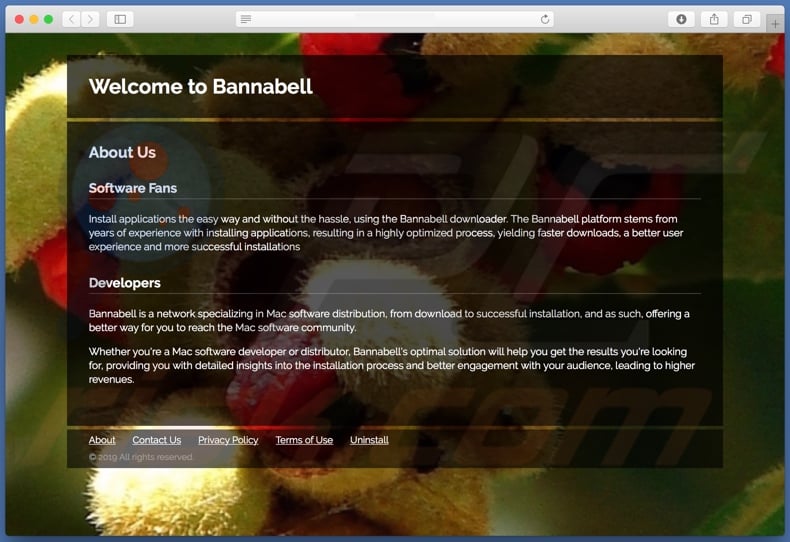
Instant automatic malware removal:
Manual threat removal might be a lengthy and complicated process that requires advanced IT skills. Combo Cleaner is a professional automatic malware removal tool that is recommended to get rid of malware. Download it by clicking the button below:
DOWNLOAD Combo CleanerBy downloading any software listed on this website you agree to our Privacy Policy and Terms of Use. To use full-featured product, you have to purchase a license for Combo Cleaner. 7 days free trial available. Combo Cleaner is owned and operated by RCS LT, the parent company of PCRisk.com.
Quick menu:
- What is search.bannabell.com?
- STEP 1. Remove search.bannabell.com related files and folders from OSX.
- STEP 2. Remove search.bannabell.com redirect from Safari.
- STEP 3. Remove search.bannabell.com browser hijacker from Google Chrome.
- STEP 4. Remove search.bannabell.com homepage and default search engine from Mozilla Firefox.
Video showing how to remove adware and browser hijackers from a Mac computer:
search.bannabell.com redirect removal:
Remove search.bannabell.com related potentially unwanted applications from your "Applications" folder:

Click the Finder icon. In the Finder window, select "Applications". In the applications folder, look for "MPlayerX","NicePlayer", or other suspicious applications and drag them to the Trash. After removing the potentially unwanted application(s) that cause online ads, scan your Mac for any remaining unwanted components.
DOWNLOAD remover for malware infections
Combo Cleaner checks if your computer is infected with malware. To use full-featured product, you have to purchase a license for Combo Cleaner. 7 days free trial available. Combo Cleaner is owned and operated by RCS LT, the parent company of PCRisk.com.
Remove browser hijacker-related files and folders

Click the Finder icon from the menu bar. Choose Go, and click Go to Folder...
 Check for browser hijacker generated files in the /Library/LaunchAgents/ folder:
Check for browser hijacker generated files in the /Library/LaunchAgents/ folder:

In the Go to Folder... bar, type: /Library/LaunchAgents/

In the "LaunchAgents" folder, look for any recently-added suspicious files and move them to the Trash. Examples of files generated by browser hijackers - "installmac.AppRemoval.plist", "myppes.download.plist", "mykotlerino.ltvbit.plist", "kuklorest.update.plist", etc. Browser hijacker commonly installs several files with the exact same string.
 Check for browser hijacker generated files in the ~/Library/Application Support/ folder:
Check for browser hijacker generated files in the ~/Library/Application Support/ folder:

In the Go to Folder... bar, type: ~/Library/Application Support/

In the "Application Support" folder, look for any recently-added suspicious folders. For example, "MplayerX" or "NicePlayer", and move these folders to the Trash.
 Check for browser hijacker generated files in the ~/Library/LaunchAgents/ folder:
Check for browser hijacker generated files in the ~/Library/LaunchAgents/ folder:

In the Go to Folder... bar, type: ~/Library/LaunchAgents/

In the "LaunchAgents" folder, look for any recently-added suspicious files and move them to the Trash. Examples of files generated by browser hijackers - "installmac.AppRemoval.plist", "myppes.download.plist", "mykotlerino.ltvbit.plist", "kuklorest.update.plist", etc. Browser hijacker commonly installs several files with the exact same string.
 Check for browser hijacker generated files in the /Library/LaunchDaemons/ folder:
Check for browser hijacker generated files in the /Library/LaunchDaemons/ folder:

In the "Go to Folder..." bar, type: /Library/LaunchDaemons/

In the "LaunchDaemons" folder, look for recently-added suspicious files. For example "com.aoudad.net-preferences.plist", "com.myppes.net-preferences.plist", "com.kuklorest.net-preferences.plist", "com.avickUpd.plist", etc., and move them to the Trash.
 Scan your Mac with Combo Cleaner:
Scan your Mac with Combo Cleaner:
If you have followed all the steps correctly, your Mac should be clean of infections. To ensure your system is not infected, run a scan with Combo Cleaner Antivirus. Download it HERE. After downloading the file, double click combocleaner.dmg installer. In the opened window, drag and drop the Combo Cleaner icon on top of the Applications icon. Now open your launchpad and click on the Combo Cleaner icon. Wait until Combo Cleaner updates its virus definition database and click the "Start Combo Scan" button.

Combo Cleaner will scan your Mac for malware infections. If the antivirus scan displays "no threats found" - this means that you can continue with the removal guide; otherwise, it's recommended to remove any found infections before continuing.

After removing files and folders generated by the browser hijackers, continue to remove rogue extensions from your Internet browsers.
Remove browser hijackers from Internet browsers
 Remove Safari browser hijackers:
Remove Safari browser hijackers:

Open the Safari browser, from the menu bar, select "Safari" and click "Preferences...".

In the preferences window, select "Extensions" and look for any recently-installed suspicious extensions. When located, click the "Uninstall" button next to it/them. Note that you can safely uninstall all extensions from your Safari browser - none are crucial for regular browser operation.
Change your homepage:
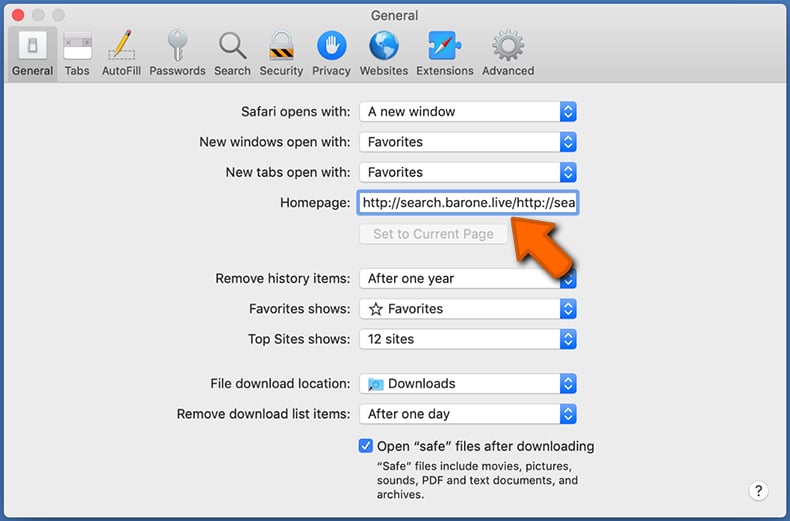
In the "Preferences" window, select the "General" tab. To set your homepage, type the preferred website URL (for example: www.google.com) in the Homepage field. You can also click the "Set to Current Page" button if you wish to set your homepage to the website you are currently visiting.
Change your default search engine:

In the "Preferences" window, select the "Search" tab. Here you will find a drop-down menu labeled "Search engine:" Simply select your preferred search engine from the drop-down list.
- If you continue to have problems with browser redirects and unwanted advertisements - Reset Safari.
 Remove Google Chrome browser hijackers:
Remove Google Chrome browser hijackers:

Click the Chrome menu icon ![]() (at the top right corner of Google Chrome), select "More Tools" and click "Extensions". Locate all recently-installed suspicious extensions, select these entries and click "Remove".
(at the top right corner of Google Chrome), select "More Tools" and click "Extensions". Locate all recently-installed suspicious extensions, select these entries and click "Remove".

Change your homepage
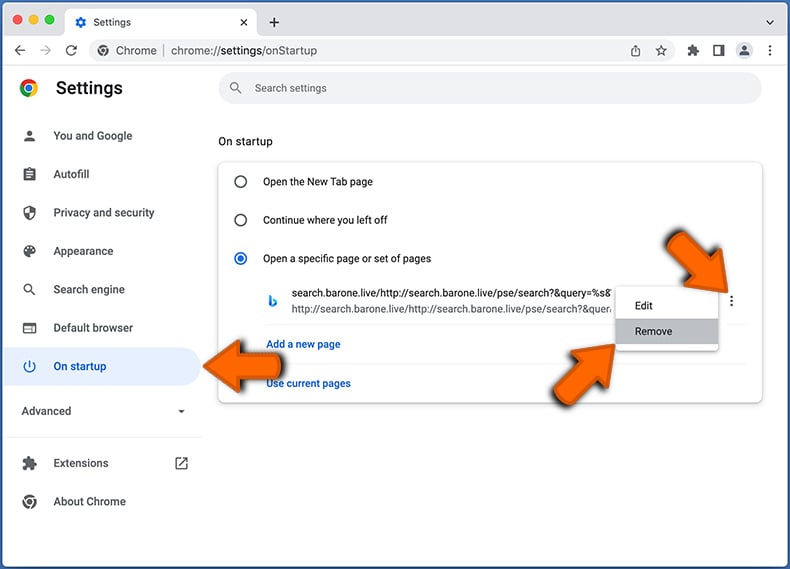
Click the Chrome menu icon ![]() (at the top right corner of Google Chrome) and select "Settings". In the "On startup" section, disable the malicious extension (if present), look for a browser hijacker URL below the "Open a specific or set of pages" option. If present, click on the three vertical dots icon and select "Remove".
(at the top right corner of Google Chrome) and select "Settings". In the "On startup" section, disable the malicious extension (if present), look for a browser hijacker URL below the "Open a specific or set of pages" option. If present, click on the three vertical dots icon and select "Remove".
Change your default search engine:
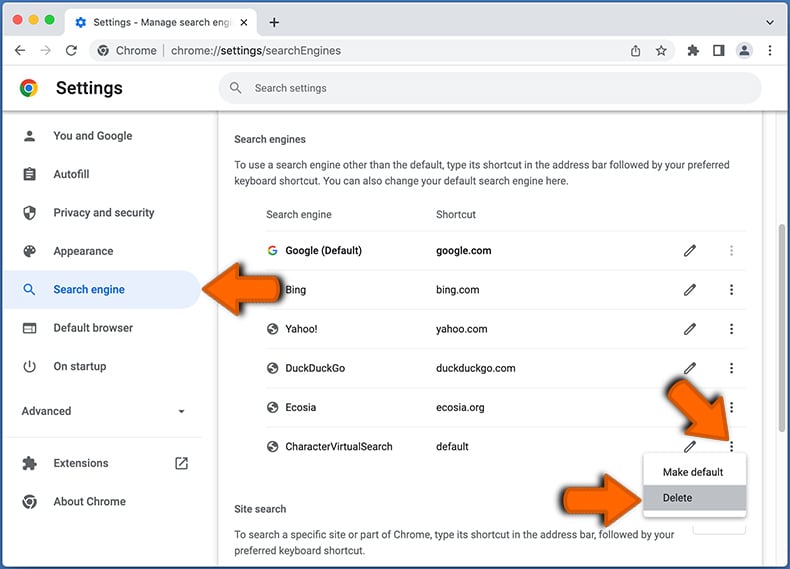
To change your default search engine in Google Chrome: Click the Chrome menu icon ![]() (at the top right corner of Google Chrome), select "Settings", in the "Search engine" section, click "Manage search engines...", in the opened list look for a browser hijacker URL, when located click the three vertical dots near this URL and select "Delete".
(at the top right corner of Google Chrome), select "Settings", in the "Search engine" section, click "Manage search engines...", in the opened list look for a browser hijacker URL, when located click the three vertical dots near this URL and select "Delete".
- If you continue to have problems with browser redirects and unwanted advertisements - Reset Google Chrome.
 Remove malicious extensions from Mozilla Firefox:
Remove malicious extensions from Mozilla Firefox:

Click the Firefox menu ![]() (at the top right corner of the main window) and select "Add-ons and themes". Click "Extensions", in the opened window locate all recently-installed suspicious extensions, click on the three dots and then click "Remove".
(at the top right corner of the main window) and select "Add-ons and themes". Click "Extensions", in the opened window locate all recently-installed suspicious extensions, click on the three dots and then click "Remove".

Change your homepage
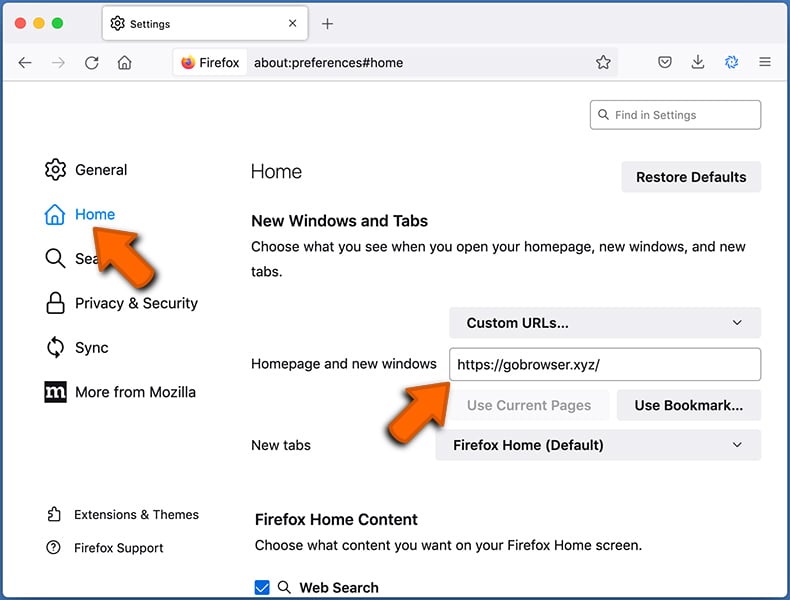
To reset your homepage, click the Firefox menu ![]() (at the top right corner of the main window), then select "Settings", in the opened window disable malicious extension (if present), remove the browser hijacker URL and enter your preferred domain, which will open each time you start Mozilla Firefox.
(at the top right corner of the main window), then select "Settings", in the opened window disable malicious extension (if present), remove the browser hijacker URL and enter your preferred domain, which will open each time you start Mozilla Firefox.
Change your default search engine:
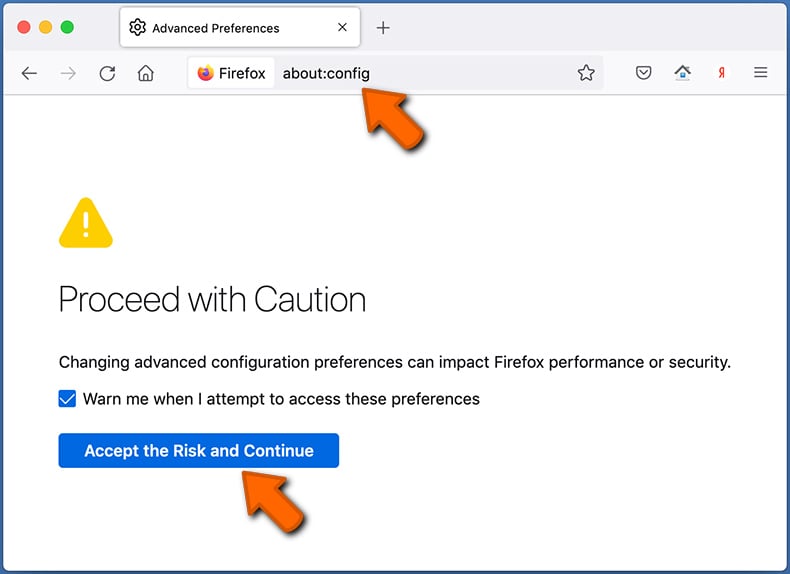
In the URL address bar, type "about:config" and press Enter. Click "Accept the Risk and Continue".
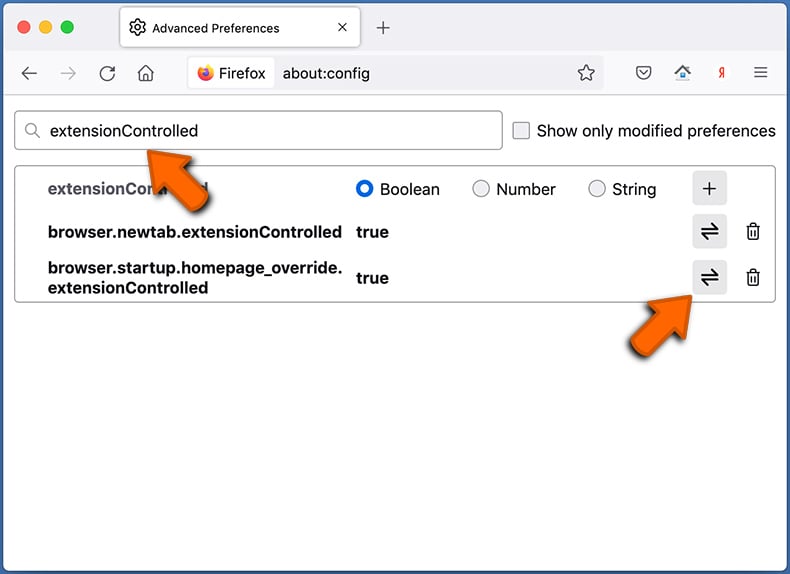
In the search filter at the top, type: "extensionControlled". Set both results to "false" by either double-clicking each entry or clicking the ![]() button.
button.
- If you continue to have problems with browser redirects and unwanted advertisements - Reset Mozilla Firefox.
Share:

Tomas Meskauskas
Expert security researcher, professional malware analyst
I am passionate about computer security and technology. I have an experience of over 10 years working in various companies related to computer technical issue solving and Internet security. I have been working as an author and editor for pcrisk.com since 2010. Follow me on Twitter and LinkedIn to stay informed about the latest online security threats.
PCrisk security portal is brought by a company RCS LT.
Joined forces of security researchers help educate computer users about the latest online security threats. More information about the company RCS LT.
Our malware removal guides are free. However, if you want to support us you can send us a donation.
DonatePCrisk security portal is brought by a company RCS LT.
Joined forces of security researchers help educate computer users about the latest online security threats. More information about the company RCS LT.
Our malware removal guides are free. However, if you want to support us you can send us a donation.
Donate
▼ Show Discussion